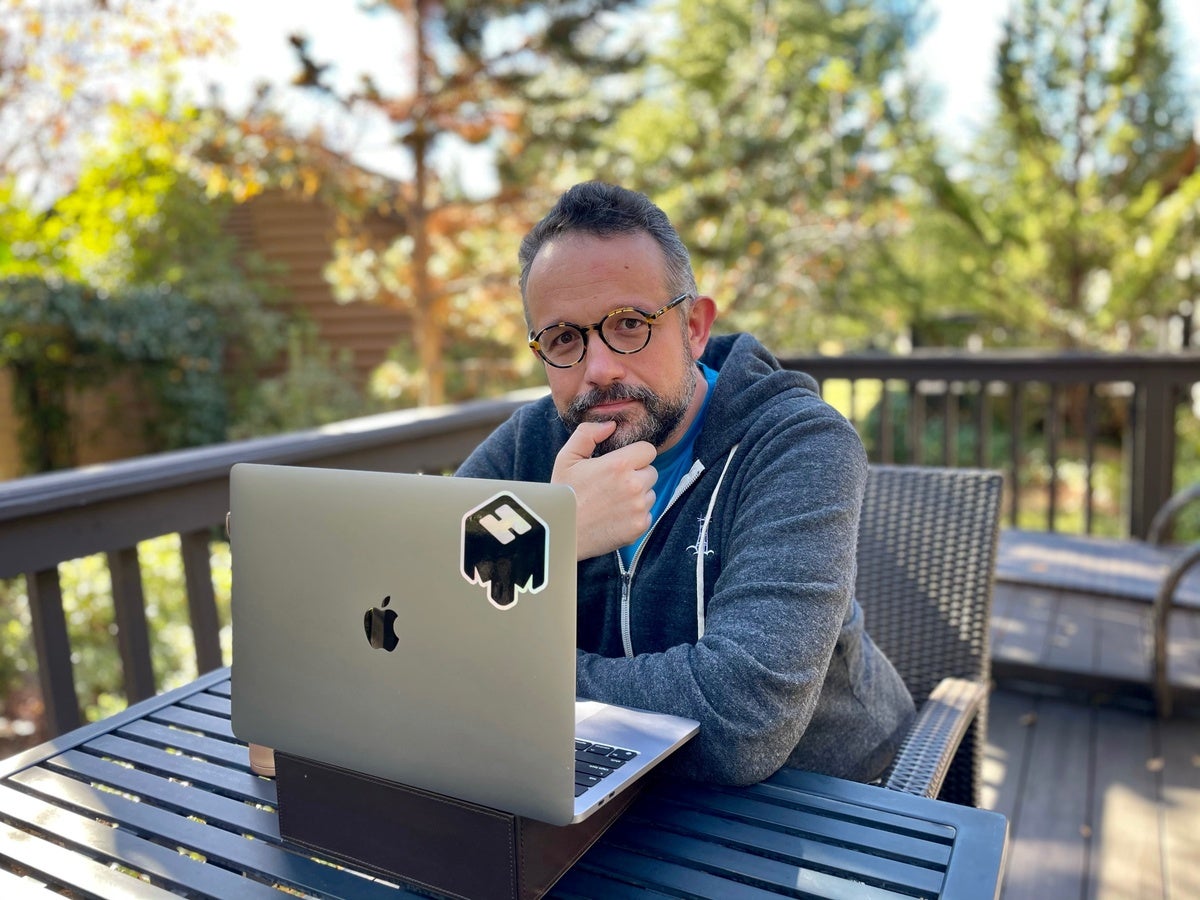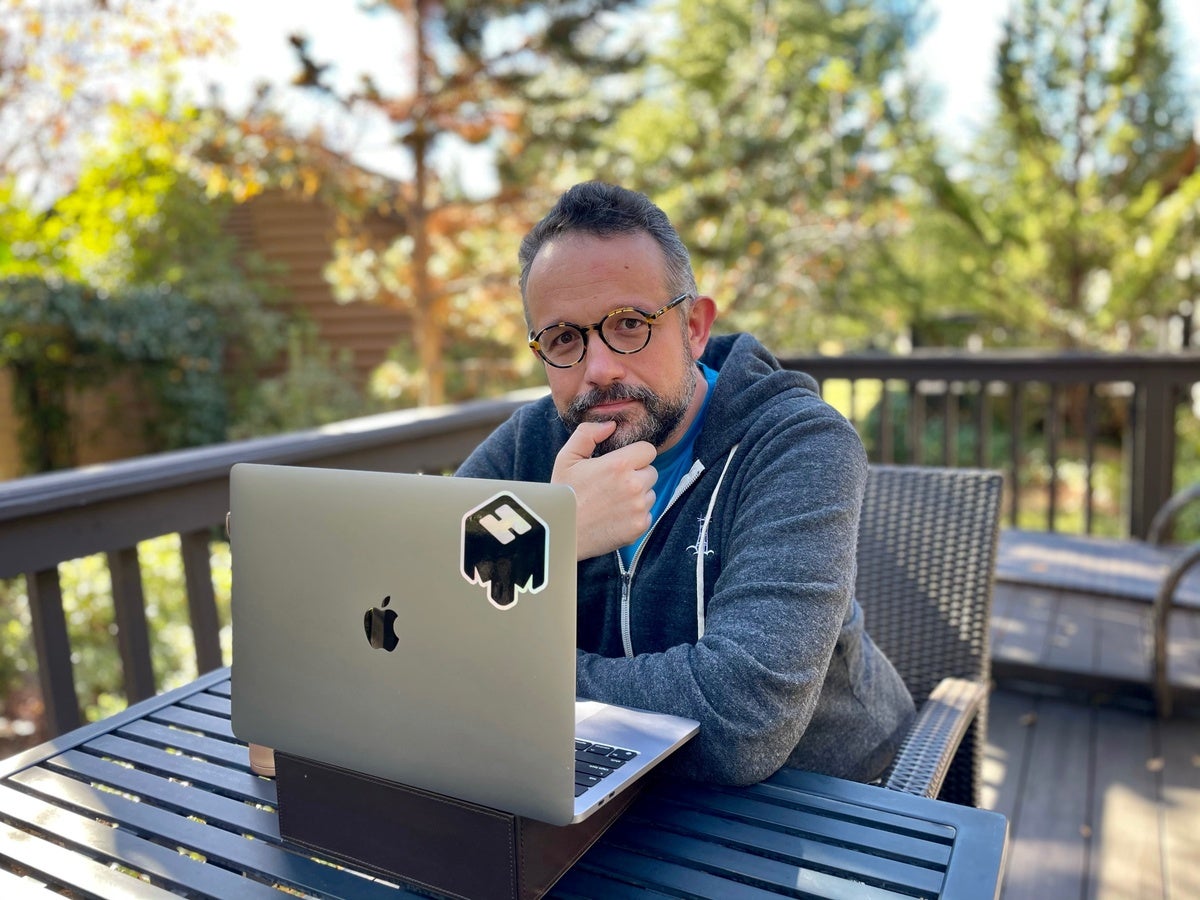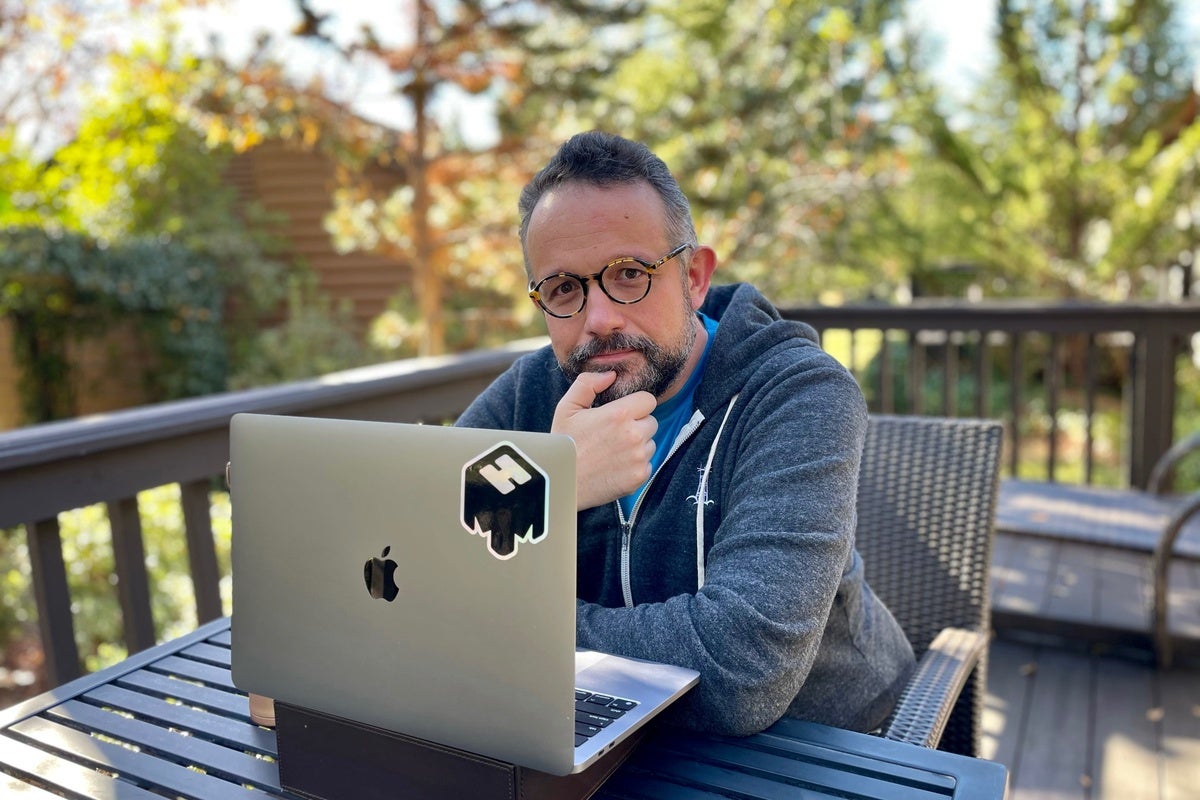
Before the COVID-19 pandemic, only around 5% of US workers toiled away at home full time. By the spring of 2020, that figure had risen to about 60%.
While some parts of the world have seen widespread vaccine rollouts allow for the reopening of offices, the majority of office-based workers aren’t planning on returning to their pre-pandemic working ways. In the UK, a survey carried out by YouGov on behalf of the BBC found that 79% of business leaders (and 70% of the general public) think it’s likely that people will never return to offices at the same rate as before the pandemic.
One US-based business leader who firmly believes this is Phil Libin. Having co-founded four companies (including note-taking app Evernote, which he left in 2016), Libin is currently the CEO and co-founder of both All Turtles and Mmhmm. A couple of months into the pandemic, All Turtles closed its three physical locations — in San Francisco, Tokyo and Paris — and now has a fully-distributed workforce across the globe. So does Mmhmm, which was spun out of All Turtles in May 2020, and lets users liven up video calls on platforms such as Zoom or Google Meet with virtual backgrounds, slides, and animations.
Libin recently spoke to Computerworld about why his companies moved to become fully distributed, what the benefits are, and why other organizations should be following suit.
This intereview with Libin has been edited for clarity and length.
What was your approach to building a distributed workspace or working environment? “It wasn’t something we’d been thinking about a ton until everything started to change in the world. At Mmhmm, we’ve been pretty lucky because we started during the pandemic, so we were always fully distributed. But, with a bunch of my other companies, we had to make the transition.
“Giving people the freedom to improve their quality of life which, for the kind of people that we have, creative knowledge workers, improves the quality of their work. In turn, improving the quality of your work gives you more meaning and fulfilment and money, which you can then use to further improve your quality of life.
“I think before [the pandemic], this feedback loop was only available to very few people, because those of us that had to work in centralized offices just couldn’t get this idea off the ground. We had to measure things purely based on results and output. Now, no one wastes time commuting, no one is expected to be on the clock at any particular time — other than a small number of people whose job is to respond within certain hours to support calls. For everyone else, we just really tried to make it fully distributed.”
How did you reach to this perspective? Was it a result of previous working experiences or conversations with employees about the kind of working environment they wanted going forward? “In the beginning of the pandemic, we didn’t have any choice. It was pretty miserable for the first couple of months, but then we realized, rather than making do while waiting to go back to the office, what if we just really leaned into it and said, ‘Well, there’s no going back, we’re never going to go back. We want to want to go forward to the way things should be. What would that be like?’
“When we flipped that switch and stopped thinking about it as a short-term problem and started thinking about it as more of an opportunity, that’s when we started figuring out how to structure ourselves to become permanently fully distributed and it was pretty important.
“I’m really glad that we did it very early on; we told people: ‘Look, we’re not going back to any office, it’s just not going to happen. So fully distributed, live wherever you want.’ That gave our employees some amount of stability and confidence because everything was so uncertain, and if you were to add on top of that, ‘What’s going to happen? Are we going to go back?’ it just becomes almost unbearable. So, largely for that reason, we said, ‘…we’re going to be fully distributed; you can move to wherever you want to move to, we’re not going to reduce your salary. If you like, move somewhere else.’ We just tried to, like, give people something they could rely on and then build up from there.
“In the beginning, it was bad because we didn’t know what we were doing, but now we’ve had a year and a half to figure it out. It’s great. This is this is by far the best way of working that I’ve ever seen.”
Do you think you would have gotten to this point without the pandemic? “No, doubt it. We were always interested in culture and optimizing things, but I think the pandemic was such a sharp…, driving force that I doubt it. Obviously, the pandemic is a big tragedy for the world, but I think there’s several silver linings and this is one of them. [Remote working] is something that could profoundly change the world for the better over the next decade.”
How important has technology, especially software and platforms, been to make this new way of working a success? “I think that technology is important. [Mmhmm] makes products for distributed teams, so obviously we use all of them and it’s been doubly good for us, because we’ve had to live with the products that we make and then develop more products that let us work the way we want to work. It’s a pretty tight feedback loop for us.
“But I think the most important thing is adopting the attitude of ‘This is a thing that we want to do.’ We’re distributed, not remote. We intentionally designed our company to be distributed because it gives us lots of advantages, and it doesn’t mean sitting at home. It doesn’t even mean working from home. It doesn’t mean never seeing other people, it doesn’t mean not seeing your co-workers. It’s just designing the system to be fully distributed, not because you have to but because you want to be better that way.
“For us, we realized we don’t want to go back to the way things were. The way things were weren’t that great. We want to take the opportunity of a change to make it better and obviously technology is a big part of it. Had we tried to make this work before COVID happened, say five years earlier, it would have probably been a lot harder because the core tools hadn’t really been deployed yet. [The pandemic] has spurred so much innovation, including here at Mmhmm. We only thought of it after COVID started because there’s a lot of new stuff that was happening.”
A lot of people have said that changing your mindset is vital to getting distributed work models off the ground. Do you think enough business leaders are willing to embrace such a big shift in how they approach work? “I was recently at a gathering with one of our investors and while it was great to have in-person conversations with folks, I found one thing really interesting. Around 60% to 70% of the executives or CEOs there were still talking about maybe having people back in the office in November and trying to figure out if people should be in for two days a week or three. They were really wrestling with this and for the majority of them, this was the main topic of conversation….
“On the other hand, there was the 30-40% of us who had decided a long time ago we were never going back to the office, and we never talked about it once. Instead, we got to chat about other things that are much more interesting.
“It really struck me how glad I am that we made this decision a year and a half ago and then I’ve had a year and a half of being productive, rather than to this day still thinking about: “Maybe it’ll be two days a week, maybe four days a week. Maybe we have an office, and we allow people to go but we don’t force them to go.” Who cares? It’s such a giant mental tax.
“Obviously, there were some companies who were hardware companies that had manufacturing floors, but there the decision is also easy. If you’re running a hospital, you’re going to have to have people show up to work. But if you’re not, and 90% of us aren’t, then it’s delusional to ask people to sit in traffic and commute to ruin their quality of life just to be in an office.”
When you first announced this policy, was there any kind of pushback or concern from employees, or did everyone completely embrace it? “Obviously, people have concerns about all sorts of stuff. But I think even the ones that were uncertain, I think they were happy for the clarity. When we told people we’re not going back to an office, it meant that people who wanted to move to be closer to their parents or their children, for example, could do that without any worry. We told our employees to figure out how they wanted to structure their life and we’d ultimately continue to support them as they did that.
“On the flipside, for those that were pretty sure they wanted to work in an office with other people, we could say: “[We] understand that, that’s not going to be us,” which is also a type of clarity that I think was quite welcome. …I think everyone at least appreciated having some clarity about what was going to happen versus maybe we’ll do this, maybe we’ll do that 12 months down the line.
“As we’ve gotten better at working at it, a lot of the things that we thought would be problems actually turned out to be great. For example, in the beginning, being distributed did mean working from home. But [in areas where things have re-opened] it doesn’t just mean working from home anymore. I don’t work from home that much, I can go to a co-working space or a coffee shop, or maybe go for a walk with a colleague of mine.
“Tomorrow, one of my employees is visiting. [At Mmhmm]…, we have budgets for getting teams together in person however often they want to, so it’s not isolating at all.
“We’ve also started being more specific about the way we communicate. In-person communication is really important, and at the moment can be quite scarce. It’s really precious because if you’re physically in the same space with other people at the same time, you don’t want to waste it. …So we try not to spend that time in a conference room showing slides to each other. That’s horrible. Now, when we have in-person interactions there’s good food and socializing involved because it doesn’t happen every day.
“Then there’s synchronous communication — it’s a live conversation but we’re not in the same place. This is still pretty important, but the only time we should be doing it is when there’s an actual conversation to be had, a proper back-and-forth where information is being shared by everyone involved.
“However, around 80% of what we do at work doesn’t actually need to take place via synchronous communication. If I’m talking and you’re not, that’s not a conversation, that’s a lecture or an update that should be pre-recorded and available to consume when best suits you. We’ve actually canceled the majority of our synchronous meetings because it just creates a better experience for everyone.
“Once everyone’s already on the same page and we’ve exchanged all the information, if we then want to have a back-and-forth discussion then we get on live video. This is the best managed company that I’ve ever run. And I know it’s only been 18 months, but I’m convinced that with another five years of figuring this out, it’s going to be magical.”
Do you think that coming from the startup world, it’s been easier for you and the people you work with to have that mindset change, compared to, say, people in charge of big established corporations that have worked the same way for hundreds of years? “Definitely, but that’s great. The fact that other people are slow to realize this is my opportunity. If everyone realized it already, then there’d be nothing left for startups to do.
“I love it that there’s big companies that are delusional about this because, first, I’m going to hire all their best employees and then sell them the software to make all this possible as they start realizing that [this way of working] is inevitable.
“It’s worked really well for us and other startups that I’ve been involved with but there’s more inertia in bigger companies, and I think some of them are figuring it out, but most of them are still struggling with it. And that is an opportunity for us.
“I think even big companies have figured out that they at least have to offer a hybrid option; I don’t know anyone who’s saying they’re going to be back in the office full-time. Everyone has made peace with the fact a proportion of employees are going to be remote all the time, so even big, traditional companies are realizing it makes sense to have hybrid teams. But I actually think that they’re wrong about hybrid, for me it’s the worst of both worlds.”
What are the biggest lessons you’ve learned and what advice would you give to companies looking to establish a distributed work model successfully? “I think it’s the shift in mindset. Stop trying to go back to the way anything was, think about it as going forward. I know that sounds kind of corny, but it’s true.
“If you take the fundamentally conservative position of, ‘I just need to wait this out so that I could return to the past,’ you’ve got to ask yourself some serious questions, like was the past really that great? Was your office culture so amazing, was your mentorship program so incredible? Did you have the work/life balance you wanted? Was your productivity like super high? The answer for most people is probably no, it wasn’t.
“…Forget about going back and think about what your culture should be, how you’re going to evolve it. As soon as you have that, then a lot of these reflexive ideas about going back to an office tend to fall away.
“For some companies, it’ll make sense to have geographically limited employees in an office, but you got to ask yourself, ‘Why?’ For the kind of stuff [Mmhmm] does, which is software, design, and engineering, I want to hire the best people from all over the world and I want to build a fully distributed company. Of course, we’ll get together from time to time, and it’ll be fun. And of course, we will have live video conversations from time to time and those will be useful. But most of the time we won’t have either of those things. Most of the time, we’ll be doing things asynchronously because we’ve shifted our mindset.”



